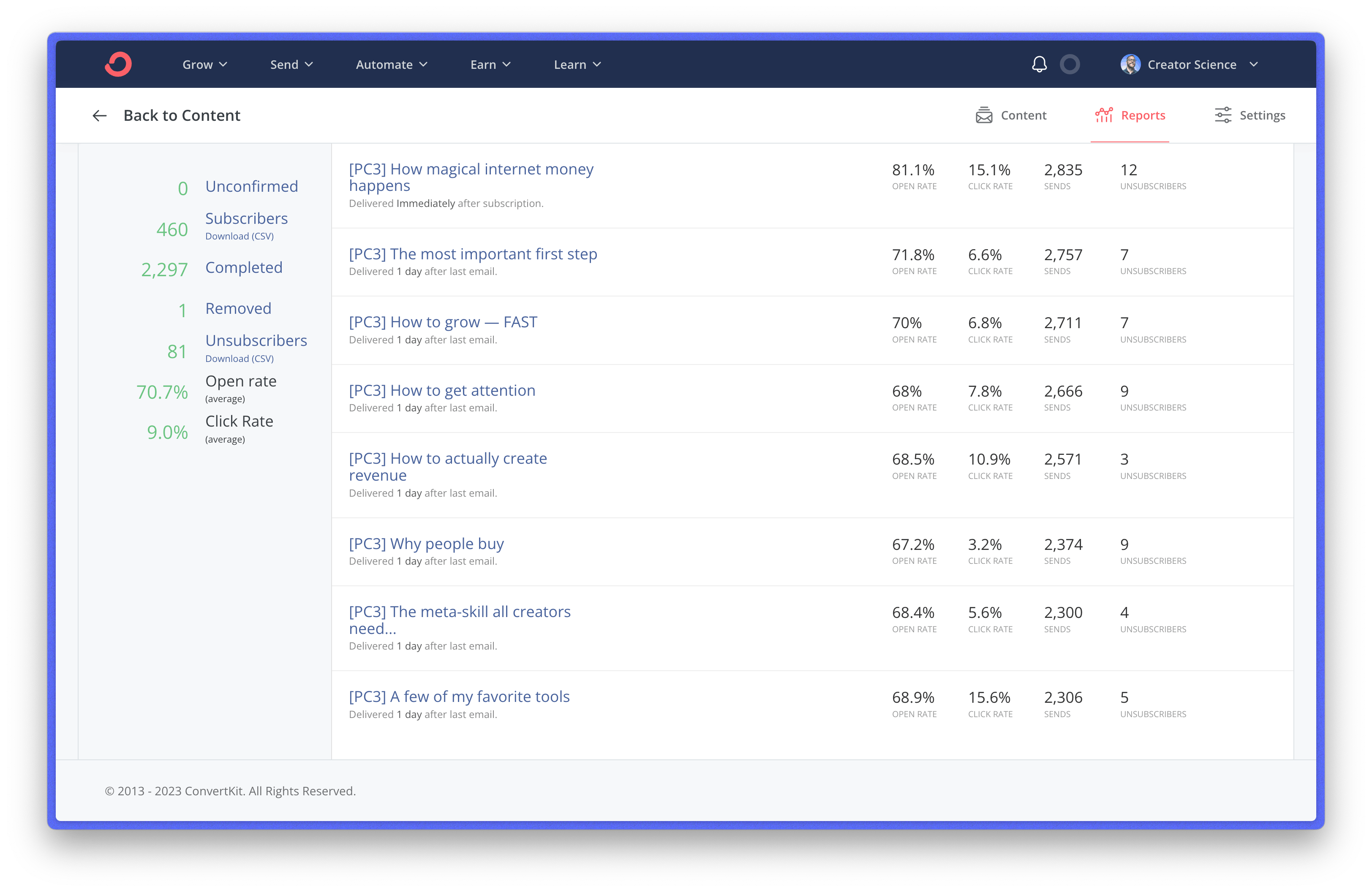The Wednesday before Thanksgiving was quiet. Nothing on my calendar, nothing on my to-do list, and I had one of those magical sparks of inspiration.
I'm going to make an email-based course today.
I'd rather say "email course" than "email-based course" but "email course" may suggest it's a course TEACHING email. But what I'm talking about here is a course that's written and delivered via email.
Several years ago, I built a blog called Freelancing School. That blog generates revenue every month because of an email course!
It's a free course that anyone can enroll in and receive 7 days of high-value writing that teaches them how to earn more as a freelancer. At the end of the course, I make an offer for my freelancing courses, and some people take me up on that.
So I've seen firsthand just how successful email-based courses could be from a passive revenue perspective, but there's another incredible reason I wanted to create one...
Email-based courses are phenomenal opt-in tools.
The results of my NEW 7-day email-based course and the results have been amazing:

If that's too small to read, let me give you the highlights:
- 40% opt-in rate (from the landing page)
- 630 new subscribers
- 2,800 total readers through the sequence
- 71% open rate
- 9% click rate
- <3% unsubscribe rate
Even though the majority of students in this course were already subscribed to Creator Science, 630 new subscribers are a significant overall lift.
When you're writing a newsletter, it can be tough getting people to opt in. We have infinite choice and subscribing to another newsletter can feel like agreeing to more emails (and stress).
A lot of creators struggle to make a compelling pitch for their newsletter too...
"Sign up for Jay's newsletter to get weekly tips and tricks!"
It's hard to be specific enough to make someone say, "YES! I want more in my inbox!"
Even with Creator Science, my pitch is "Become a smarter creator in 10 minutes per week."
That's OK, it says:
- WHO the newsletter is for
- WHAT the intended outcome is
- HOW MUCH time it takes to read
...but it's still pretty unclear what the next newsletter will teach me.
Enter the email-based course. One of the most effective lead magnets today.
Instead of asking people to subscribe to a newsletter, you hook them with a very specific and time-bound outcome.
Here's the copy on the current landing page:
Everyone is publishing content online.
...but few are actually getting paid to do it.
So we created the Professional Creator Crash Course to teach YOU how to earn a living as a professional creator (in just a few days).
Specific language = compelling pitch = more conversions.
Almost 2x our homepage performance!

There are three other distinct benefits to an email-based course:
- Speed to trust
- Referrability
- Potential for improvement
Let's dig into each of them.
Speed to trust
Without the course, new subscribers have a pretty average initial experience:
- They get a 2-day welcome sequence
- Within the first 7 days, they'll get their first newsletter
Hopefully, I'm on my game that week and the newsletter is great!
But this email-based course is the equivalent of 7 proven, high-quality newsletters delivered for a week straight. I KNOW that the content will be good (and consistent) for every single subscriber.
And because I know the content is good, I know that I'm positioning myself as someone who is 1.) knowledgeable and 2.) trustworthy. Within a week, I create a great first impression that starts my relationship with the reader off on a great foot.
Not only that – but the reader's inbox sees that emails from [email protected] are opened and is more likely to land them in the Primary inbox.
Referrability
If email is part of your content strategy (and I believe it should be) then you want to do everything you can to direct attention you're getting OUTSIDE of email into email.
Example: If you are a guest on a podcast, you believe that the podcast audience is a fit for your work. So how do you get them to subscribe via email?
You could wait until the host asks you, "Where can people find you?" and hope people listen...OR you could have a high-quality email-based course that you bring up casually in conversation.
"I'm glad you asked that question – I actually have a free email course that can teach you how to become a professional creator. Your listeners can get that at creatorscience.com/course. Anyway..."
Ramit Sethi is a master of this in his podcast.
The same is true for any Q&A you're doing, webinar you're hosting, presentation you're giving, or conversation you're having. This asset is incredibly referrable and makes it easier for you to turn any form of attention into an email subscriber.
Potential for improvement
I obsess over user experience. It comes from my background in software, but I apply that lens to reader experience, listener experience, viewer experience, and member experience.
With most emails, the experience design is ALL upfront. You write the newsletter, but it's a one-and-done broadcast. If I had a bad subject line or a typo, it can't be fixed – onto the next one.
But with an email course, I can make tiny changes and see immediate feedback on their impact. If I see one email in my sequence has an abnormally low open rate, I can edit that subject line for all future recipients.
I can tweak ALL aspects until it performs as well as I can make it – and that ceiling seems super high!
Wrap up
I slept on email-based courses for too long. Now that I have one, I'm starting to plan the next one.
Don't make my mistake! Prioritize developing your own.
And if you haven't already, check out our Professional Creator Crash Course.


